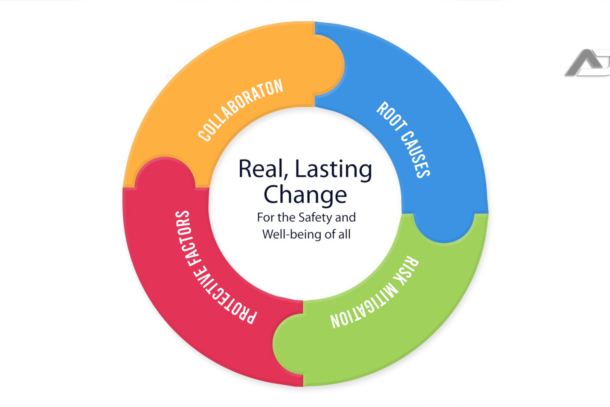Abid Jan
To develop effective municipal CSWB plans, it’s essential to understand the objectives behind them. Historically, research and community safety experts have worked to ensure community safety and well-being from two perspectives. On one side, they aimed to ensure that police services fully embrace a community policing approach across their organizations. On the other side, they sought to create a mechanism for community partners to recognize community safety as a shared responsibility and to provide a framework that fosters collaboration with local police services.
Efforts to enhance policing led to the introduction of the Community Safety and Well-Being (CSWB) framework. This framework offers each police service an opportunity to review its work through the CSWB lens, identify priority actions, and establish key performance indicators at every level, along with the support needed to operationalize local CSWB plans.
On the community side, the province of Ontario mandated the development of local CSWB Plans using the same four levels of intervention. The key lies in ensuring two things: 1) assessing and identifying not just community priority issues, but also applying the CSWB lens to pinpoint risk factors and determine what partners can do together to strengthen corresponding protective factors.
This approach goes beyond identifying broad, generic issues. It requires identifying the risk factors that lead to community safety concerns in order “to address the root causes of crime and complex social issues by focusing on social development, prevention, and risk intervention.”
The framers of the CSWB approach were intentional in ensuring police-community collaboration. The guidelines clearly emphasize that community safety and well-being cannot rest solely on the shoulders of the police. Collaboration and minimizing risk factors are key goals, as highlighted in the provincial guidelines:
“It is a shared responsibility by all members of the community and requires an integrated approach to bring municipalities, First Nations and community partners together to address a collective goal. 𝗕𝗿𝗲𝗮𝗸𝗶𝗻𝗴 𝗱𝗼𝘄𝗻 𝗲𝘅𝗶𝘀𝘁𝗶𝗻𝗴 𝘀𝗶𝗹𝗼𝘀 and encouraging 𝗺𝘂𝗹𝘁𝗶-𝘀𝗲𝗰𝘁𝗼𝗿𝗮𝗹 𝗽𝗮𝗿𝘁𝗻𝗲𝗿𝘀𝗵𝗶𝗽𝘀 are essential in developing strategies, programs and services to help 𝗺𝗶𝗻𝗶𝗺𝗶𝘇𝗲 𝗿𝗶𝘀𝗸 factors and improve the overall well-being of our communities.”
The commitment to making CSWB planning mandatory is rooted in the need to address crime, victimization, and violence through a collaborative service delivery model:
“…Our government is 𝗰𝗼𝗺𝗺𝗶𝘁𝘁𝗲𝗱 𝘁𝗼 𝗳𝗶𝗴𝗵𝘁𝗶𝗻𝗴 𝗰𝗿𝗶𝗺𝗲, 𝘃𝗶𝗰𝘁𝗶𝗺𝗶𝘇𝗮𝘁𝗶𝗼𝗻 𝗮𝗻𝗱 𝘃𝗶𝗼𝗹𝗲𝗻𝗰𝗲 on every front because each and every person deserves to live in a safe, secure community.[1]
“Police are often called upon to respond to complex situations that are non-criminal in nature as they operate on a 24/7 basis. We also know that many of these situations, such as an individual experiencing a mental health crisis, would be more appropriately managed through a 𝗰𝗼𝗹𝗹𝗮𝗯𝗼𝗿𝗮𝘁𝗶𝘃𝗲 𝘀𝗲𝗿𝘃𝗶𝗰𝗲 𝗱𝗲𝗹𝗶𝘃𝗲𝗿𝘆 𝗺𝗼𝗱𝗲𝗹 that leverages the strengths of partners in the community.”
The theme of addressing priority risks and engaging in holistic planning with all key partners is reiterated throughout the provincial guidelines:
“By working collaboratively at the local level to 𝗮𝗱𝗱𝗿𝗲𝘀𝘀 𝗽𝗿𝗶𝗼𝗿𝗶𝘁𝘆 𝗿𝗶𝘀𝗸𝘀 and needs of the community through strategic and 𝗵𝗼𝗹𝗶𝘀𝘁𝗶𝗰 𝗽𝗹𝗮𝗻𝗻𝗶𝗻𝗴, we will be better prepared to meet current and future expectations of Ontarians.”
The expectation for CSWB plans is to ensure “long-term benefits of social development and prevention,” while simultaneously working to “mitigate acutely elevated risk.”
This type of planning requires less dependence on reactionary, incident-driven responses and 𝗿𝗲-𝗳𝗼𝗰𝘂𝘀𝗶𝗻𝗴 𝗲𝗳𝗳𝗼𝗿𝘁𝘀 𝗮𝗻𝗱 𝗶𝗻𝘃𝗲𝘀𝘁𝗺𝗲𝗻𝘁𝘀 𝘁𝗼𝘄𝗮𝗿𝗱𝘀 𝘁𝗵𝗲 𝗹𝗼𝗻𝗴-𝘁𝗲𝗿𝗺 𝗯𝗲𝗻𝗲𝗳𝗶𝘁𝘀 𝗼𝗳 𝘀𝗼𝗰𝗶𝗮𝗹 𝗱𝗲𝘃𝗲𝗹𝗼𝗽𝗺𝗲𝗻𝘁, 𝗽𝗿𝗲𝘃𝗲𝗻𝘁𝗶𝗼𝗻, 𝗮𝗻𝗱 𝗶𝗻 𝘁𝗵𝗲 𝘀𝗵𝗼𝗿𝘁-𝘁𝗲𝗿𝗺, 𝗺𝗶𝘁𝗶𝗴𝗮𝘁𝗶𝗻𝗴 𝗮𝗰𝘂𝘁𝗲𝗹𝘆 𝗲𝗹𝗲𝘃𝗮𝘁𝗲𝗱 𝗿𝗶𝘀𝗸.
The guidelines encourage planning across all four levels of intervention, with “a strong role for the police,” while urging partners to think in new ways about local issues and potential solutions by exploring options to address risks through social development, prevention, and risk intervention. This is identified as a critical success factor:
Critical success factor[2]
𝗰𝗼𝗺𝗺𝘂𝗻𝗶𝘁𝘆 𝘀𝗮𝗳𝗲𝘁𝘆 𝗮𝗻𝗱 𝘄𝗲𝗹𝗹-𝗯𝗲𝗶𝗻𝗴 𝗽𝗹𝗮𝗻𝗻𝗶𝗻𝗴 𝗳𝗿𝗮𝗺𝗲𝘄𝗼𝗿𝗸 𝗶𝘀 𝗶𝗻𝘁𝗲𝗻𝗱𝗲𝗱 to get municipalities, First Nations and their partners thinking in new ways about local issues and potential solutions by 𝗲𝘅𝗽𝗹𝗼𝗿𝗶𝗻𝗴 𝗼𝗽𝘁𝗶𝗼𝗻𝘀 𝘁𝗼 𝗮𝗱𝗱𝗿𝗲𝘀𝘀 𝗿𝗶𝘀𝗸𝘀 through social development, prevention and risk intervention.[3]
Community members and service providers are expected to “document risks as the first step.” The planning template and the extensive list of risk factors provided reflect this focus. Without addressing these critical factors, a plan may exist, but it will not lead to any tangible action or outcomes linked to community safety, as expected by the ministry.
Ultimately, the province’s objective is clear: through multi-partner collaboration, we must address the root causes of community safety concerns, mitigate risk factors, and strengthen protective factors—ensuring that every plan leads to real, lasting change for the well-being of all.
[1] Government of Ontario. (n.d.). Community safety and well-being planning framework: A shared commitment in Ontario (Booklet 3). Retrieved from https://www.ontario.ca/document/community-safety-and-well-being-planning-framework-booklet-3-shared-commitment-ontario
[2] Government of Ontario. (n.d.). Section 3: Critical success factors. In Community safety and well-being planning framework: A shared commitment in Ontario (Booklet 3). Retrieved from https://www.ontario.ca/document/community-safety-and-well-being-planning-framework-booklet-3-shared-commitment-ontario/section-3-critical-success-factors
[3] Government of Ontario. (n.d.). Community safety and well-being planning framework: A shared commitment in Ontario (Booklet 3) [PDF]. Huron Shores. Retrieved from https://huronshores.ca/wp-content/uploads/2022/08/Community-Safety-and-Well-Being-Planning-Framework-A-Shared-Commitment-in-Ontario-Booklet-3.pdf
